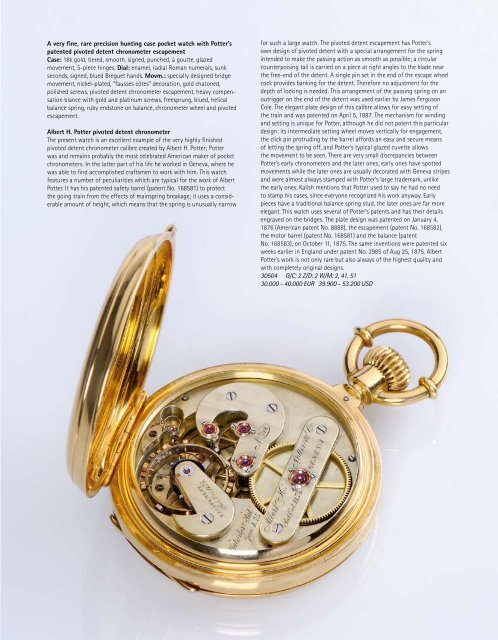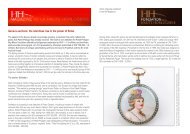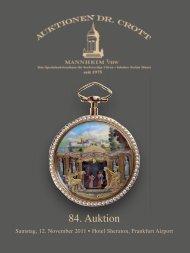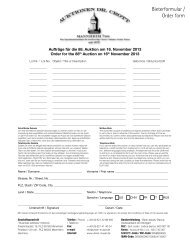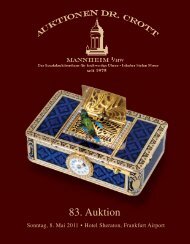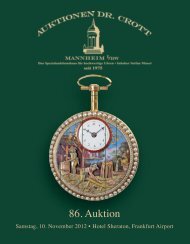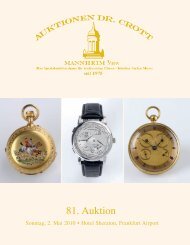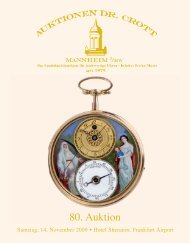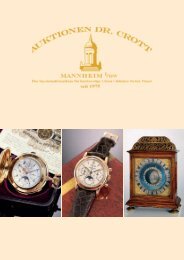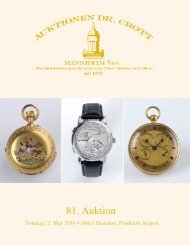- Seite 1:
81. Auktion Sonntag, 2. Mai 2010
- Seite 4 und 5:
Unser Team / Our Team Susanne Bruck
- Seite 6 und 7:
Hinweise zur Auktion Saalbieter Wen
- Seite 8 und 9:
Internationale Repräsentanten Inte
- Seite 10 und 11:
Eine Sammlung bibliophiler Kostbark
- Seite 12 und 13:
16 Strnadt, Anton (Kaiserl. Königl
- Seite 14 und 15:
50 Konvolut aus 12 Niellosilber- Uh
- Seite 16 und 17:
56* Konvolut aus sechs dekorativen
- Seite 18 und 19:
62 “JM”, Paris, 85 x 31 x 15 mm
- Seite 20 und 21:
65 Hochfeine, extrem seltene Achat-
- Seite 22 und 23:
67* Jean Jaques Prevost, 79 x 39 x
- Seite 24 und 25:
am Liebesaltar, Korpusrückseite mi
- Seite 26 und 27:
74 Feine Achat-Schnupftabakdose mit
- Seite 28 und 29:
76 “C+C”, Registered Number 734
- Seite 30 und 31:
80 Julius Hügler in Wien zugeschri
- Seite 33 und 34:
82 Cartier, “Montre de Tableau de
- Seite 35 und 36:
84 “JCL”, Genève, Werk Nr. 113
- Seite 37 und 38:
86 Fabergé, St. Petersburg/ Werkme
- Seite 40:
88 “JEB” (Joseph-Etienne Blerzy
- Seite 44:
90 Charles Bruguier à Genève, 95
- Seite 47 und 48:
92 International Watch Co. Schaffha
- Seite 49 und 50:
97 98 99 97 International Watch Co.
- Seite 51 und 52:
103 104 105 103 International Watch
- Seite 53 und 54:
109 110 111 109 International Watch
- Seite 55 und 56:
115 116 117 115 International Watch
- Seite 57 und 58:
121 122 123 121 International Watch
- Seite 59 und 60:
127 128 129 127 International Watch
- Seite 61 und 62:
133 134 135 133 International Watch
- Seite 63 und 64:
139 140 141 139 International Watch
- Seite 65 und 66:
146 147 145 145 A. Lange & Söhne G
- Seite 67 und 68:
150 151* 150 A. Lange & Söhne Glas
- Seite 69 und 70:
153 Adolph Lange Dresden · Werk Nr
- Seite 71 und 72:
156 Deutsche Uhrenfabrikation Glash
- Seite 73 und 74:
159 Richard Lange, Glashütte b. Dr
- Seite 75 und 76:
162 A. Lange & Söhne Glashütte B/
- Seite 77 und 78:
165* A. Lange & Söhne Glashütte i
- Seite 79 und 80:
167 Deutsche Uhrenfabrikation Glash
- Seite 81 und 82:
169 J. Assmann, Dresden, Werk Nr. 5
- Seite 84:
171 A. Lange & Söhne Glashütte i/
- Seite 88 und 89:
173 174 173 A. Lange & Söhne Glash
- Seite 90:
177 A. Lange & Söhne, Glashütte i
- Seite 93 und 94:
179* International Watch Co., Schaf
- Seite 95 und 96:
181 Officine Panerai, “Ferrari Ra
- Seite 97 und 98:
An as new, extremely rare, decorati
- Seite 100 und 101:
185 Omega “Chronometer Automatic
- Seite 102 und 103:
189 Cartier “Pasha”, Geh. Nr. 3
- Seite 104 und 105:
193* 194 193* Rolex “Oyster Perpe
- Seite 106 und 107:
197 Omega/Louis Brandt, Werk Nr. 13
- Seite 108 und 109:
201 Patek Philippe Genève · Werk
- Seite 110:
203* Breguet “Heritage Chronograp
- Seite 113 und 114:
207 208 207 Patek Philippe Genève
- Seite 115 und 116:
211 212 211 Jaeger Le Coultre, “G
- Seite 117 und 118:
214 Jaeger Le Coultre “Master Com
- Seite 119 und 120:
217 Jaeger Le Coultre, “Reverso 6
- Seite 121 und 122:
221* Cartier “Tank American Chron
- Seite 124:
224 Corum “Classical Tourbillon M
- Seite 127 und 128:
227 Patek Philippe Genève · Werk
- Seite 129 und 130:
229 Jaeger-Le Coultre “Master Con
- Seite 131 und 132:
233 234 233 Omega “Cosmic Automat
- Seite 133 und 134:
237 Patek Philippe Genève · Werk
- Seite 135 und 136:
239 240
- Seite 138:
242 Patek Philippe & Co. Genève ·
- Seite 142 und 143:
244 Michael Butterfield, Paris, cir
- Seite 144 und 145:
248 Johann Willebrand in Augspurg,
- Seite 146 und 147:
252 Carl Adam Ruth, Norrköping, We
- Seite 148 und 149:
254 Jeann Carleson, London, Werk Nr
- Seite 150:
256 David Buschmann, Augustinus, 17
- Seite 154:
258* Johann Kaesborer, Ulm, 130 x 1
- Seite 158 und 159:
260 Carl Crems, verm. Königsberg,
- Seite 160: 262 Unsigniert, 112 x 112 x 60 mm,
- Seite 164 und 165: 264 Martin Bentwe in Wienn, 1650 gr
- Seite 166: 266 Le Roy à Paris, 128 mm, 1324 g
- Seite 170: 268 Marcus Böhm, Augusta, Höhe 78
- Seite 173 und 174: 271 Franz Lidecke, Geestemünde “
- Seite 175 und 176: 273 Molyneux & Sons, 44 Devonshire
- Seite 177 und 178: 275 J. Player & Son Ltd., Coventry,
- Seite 179 und 180: 277 Vacheron & Constantin à Genèv
- Seite 181 und 182: 279 J. L. & A. Breguelin, Tramelan,
- Seite 183 und 184: 281* Omega / L. Brandt & frère, S.
- Seite 185 und 186: 285* Patek Philippe à Genève, Wer
- Seite 188: A gentleman’s important and heavy
- Seite 192 und 193: 289 Emil Delépine, Marina de Chile
- Seite 194 und 195: 291 John Poole, London, Maker to th
- Seite 196: 293 Parkinson & Frodsham, Change Al
- Seite 200 und 201: 295* Chronometer Movado “Chronom
- Seite 202 und 203: 297 Ulysse Nardin, Locle Suisse, We
- Seite 204: 299* Paul Ditisheim, La Chaux-de-Fo
- Seite 207 und 208: 300 Deutsche Uhrmacherschule Glash
- Seite 210: 302 Louis Raby, H. de L’Empereur,
- Seite 216: 305 Charles Frodsham, By Appointmen
- Seite 219 und 220: A gentleman’s important, extremel
- Seite 222: 309 S. Smith & Son, 9 Strand, Londo
- Seite 226 und 227: 311 S. Smith & Son, 9 Strand, Londo
- Seite 228 und 229: 313 L. Leroy & Cie., Horlogers de l
- Seite 230: 316 J.W. Benson, 25 Old Bond Street
- Seite 233 und 234: 318 Jules Jürgensen, Copenhagen, W
- Seite 236: 320 Dent “Watchmaker to the King
- Seite 239 und 240: 322 Patek Philippe & Cie. Genève,
- Seite 241 und 242: 324 Coventry Co-operative Watch Man
- Seite 243 und 244: 326 French, Royal Exchange, London,
- Seite 245 und 246: 328 Charles Frodsham, 84 Strand Lon
- Seite 248 und 249: 330 Meuron et Compe., Werk Nr. 3848
- Seite 250 und 251: 334 Thomas Gray, Sackville Street,
- Seite 252 und 253: 336 Unsigniert, England, Werk Nr. 1
- Seite 254: An in museum like quality, very fin
- Seite 258: A very fine quarter repeating gold
- Seite 262:
343 John Faver, London, Werk Nr. 67
- Seite 265 und 266:
345 Joseph Windmills, London, 53 mm
- Seite 268 und 269:
A very fine Repoussé quarter repea
- Seite 270 und 271:
350 Frères Bordier à Genève, Geh
- Seite 272:
352 Auguste Martinet à Berlin, “
- Seite 276:
A fine, heavy pair-cased quarter re
- Seite 280 und 281:
356 A. Lange & Söhne Glashütte B/
- Seite 282:
359 Konvolut aus 2 Taschenuhren / L
- Seite 285 und 286:
361 A. Lange & Söhne, Glashütte B
- Seite 288:
363 Deutsche Uhrenfabrikation Glash
- Seite 292:
365 A. Lange & Söhne Glashütte B/
- Seite 296:
Adolf Kittel Adolf Kittel wurde 184
- Seite 299 und 300:
Uhrmacher und Konstrukteur Hugo Mü
- Seite 301 und 302:
371 372 371 International Watch Co.
- Seite 303 und 304:
374 A. Lange & Söhne, Glashütte i
- Seite 306:
An aviator’s large and very fine
- Seite 310:
379 Rolex SA-Genève, Officine Pane
- Seite 313 und 314:
383 384 385 383 Breguet à Paris, W
- Seite 315 und 316:
388 Vever à Paris, 28 mm, 48 gr.,
- Seite 317 und 318:
390 Unsigniert, Schweiz, 39 mm, 64
- Seite 319 und 320:
393 Patek Philippe & Co. Genève, W
- Seite 321 und 322:
396 J. Calame-Robert, La Chaux de F
- Seite 323 und 324:
398 Meuron & Cie à Genève, Geh. N
- Seite 325 und 326:
401 Unsigniert, Werk Nr. 8300, Geh.
- Seite 327 und 328:
404 Unsigniert, Geh. Nr. 856, 56 mm
- Seite 329 und 330:
407 “Gastone de Medici”, 39 x 4
- Seite 331 und 332:
410 411 412 410 Romilly á Paris, 3
- Seite 334 und 335:
414 Barraud, London, Werk Nr. 3225,
- Seite 336 und 337:
417 Unsigniert, Schweiz, Geh. Nr. 1
- Seite 338 und 339:
421 Unsigniert, Paris, 39 mm, 61 gr
- Seite 340 und 341:
424* Unsigniert, Schweiz, Geh. Nr.
- Seite 342:
426 Daniel Ekegrén, Kiobenhavn, Ge
- Seite 345 und 346:
429 Unsigniert, vermutlich Frankrei
- Seite 347 und 348:
432 Unsigniert, Fleurier, Geh. Nr.
- Seite 350:
434 George Prior, London, Werk Nr.
- Seite 353 und 354:
438 Omega “Seamaster Automatic 60
- Seite 355 und 356:
442* Omega “Seamaster”, Werk Nr
- Seite 357 und 358:
446 Omega “Speedmaster Profession
- Seite 359 und 360:
448 Zenith “Chronometre”, Werk
- Seite 361 und 362:
452 Omega Watch Co., Swiss, Werk Nr
- Seite 363 und 364:
454 Le Roy & Fils, Palais Royal, Ga
- Seite 366 und 367:
456 Helvetia, 48 mm, 63 gr., circa
- Seite 368 und 369:
459 Konvolut aus 11 Taschenuhren /
- Seite 370 und 371:
461 Konvolut aus 6 Taschenuhren / L
- Seite 372 und 373:
463 Konvolut aus 4 silbernen Tasche
- Seite 374 und 375:
465 Rolex “Oyster”, Geh. Nr. 24
- Seite 376 und 377:
467 Rolex “Precision”, Geh. Nr.
- Seite 378:
469 Rolex “Prince Brancard”, We
- Seite 381 und 382:
472 473 472 Rolex “Oyster Perpetu
- Seite 383 und 384:
475 Rolex “Oyster Perpetual GMT-M
- Seite 386 und 387:
477 Rolex “Cellini”, Geh. Nr. 4
- Seite 388 und 389:
480 481* 480 Rolex “Oyster Perpet
- Seite 390 und 391:
484 Rolex “Oyster Perpetual Subma
- Seite 392 und 393:
486 Rolex “Oyster Perpetual Date
- Seite 394:
488 Rolex “Oyster Perpetual Subma
- Seite 397 und 398:
490 Rolex “Oyster Cosmograph Dayt
- Seite 400:
492 Rolex “Cosmograph Daytona”
- Seite 404 und 405:
494 International Watch Co., Schaff
- Seite 406 und 407:
496 Universal Genève, Geh. Nr. 185
- Seite 408 und 409:
499 Breitling à Genève, “Chrono
- Seite 410 und 411:
502 International Watch Co. Schaffh
- Seite 412 und 413:
505* 506 505* International Watch C
- Seite 414 und 415:
509 Feine diamantbesetzte Damenarmb
- Seite 416 und 417:
513 Vacheron & Constantin à Genèv
- Seite 418 und 419:
516 Patek Philippe à Genève, Werk
- Seite 420:
519* Patek Philippe à Genève, Wer
- Seite 423 und 424:
522 Patek Philippe Genève · “El
- Seite 425 und 426:
525* 526 525* Patek Philippe Genèv
- Seite 427 und 428:
529* Patek Philippe Genève · Werk
- Seite 430 und 431:
531 Patek Philippe Genève · Werk
- Seite 432 und 433:
534 Patek Philippe Genève · Werk
- Seite 434 und 435:
537 Patek Philippe Genève · Nauti
- Seite 436:
539 Patek Philippe Genève · Werk
- Seite 440:
541 Abraham Guer à Angolême, 68 m
- Seite 444 und 445:
543 Larpent & Jürgensen, Kiöbenha
- Seite 446 und 447:
548* L. LeRoy & Cie. Horlogers de l
- Seite 448 und 449:
551 Euge. Bornand & Cie à Saint Cr
- Seite 450 und 451:
554 Systéme Glashütte, Werk Nr. 1
- Seite 452 und 453:
557 International Watch Co., Geh. N
- Seite 454 und 455:
560* L. C. GrandJean, Locle, Swiss,
- Seite 456 und 457:
562* LeCoultre & Cie., Le Sentier,
- Seite 458:
564 Louis Audemars, Brassus et Gèn
- Seite 462:
566* Audemars, Piguet & Co., Brassu
- Seite 466:
569* “LBF” (Louis Brandt Frère
- Seite 470:
571 Patek Philippe & Cie. Genève,
- Seite 474 und 475:
573* Gideon & Co., Locle, Swiss, Ge
- Seite 476:
574 J.W. Benson, 25 Old Bond Street
- Seite 480:
576 Renevier, Eleve de Breguet, Fec
- Seite 483 und 484:
Bewertungssystem Verehrte Kunden, u
- Seite 485 und 486:
Bieterformular / Order form Aufträ
- Seite 487 und 488:
Mondani time for luxury GUIDO MONDA


